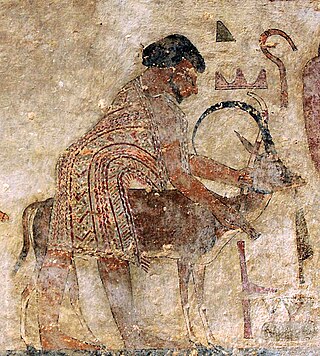Top Qs
Timeline
Chat
Perspective
Aamu
Ancient Egyptian ethnonym for Western Asiatic peoples From Wikipedia, the free encyclopedia
Remove ads
Aamu (Ancient Egyptian: 𓂝𓄿𓅓𓅱, romanized: ꜥꜣmw) was a name used to designate West Asians in ancient Egypt.[1] It is often translated as "Western Asiatic", but it might refer specifically to Canaanites or Amorites.[1][2] The Egyptologist and linguist Thomas Schneider states that ꜥꜣm was attested as early as the Sixth Dynasty of Egypt and is likely a loanword from early Semitic term drmj, "inhabitant of the south (of Palestine)".[5]
Procession of the Aamu
A group of West Asiatic foreigners, possibly Canaanites, labelled as Aamu (ꜥꜣmw), including the leading man with a Nubian ibex labelled as Abisha the Hyksos (𓋾𓈎𓈉, ḥqꜣ-ḫꜣswt, Heqa-khasut for "Hyksos"). Tomb of 12th-dynasty official Khnumhotep II, who served under Senusret III, at Beni Hasan c. 1900 BCE.[1][2][3][4]

(𓋾𓈎𓈉, ḥqꜣ-ḫꜣswt, Heqa-khasut for "Hyksos").
Tomb of Khnumhotep II, circa 1900 BCE.[1]
Contemporary Egyptian sources from the time of the wars against the Hyksos also refer to the latter as ꜥꜣmw. Although they have left no inscriptions in their own language, some of their personal names have turned up in Egyptian records, which are a syntactical and lexical match for West Semitic dialects.[6] An ancient Egyptian painting in the tomb of 12th Dynasty official Khnumhotep II, at Beni Hasan (c. 1900 BCE), shows a group of West Asiatic foreigners, possibly Canaanites, labelled as Aamu (ꜥꜣmw), including the leading man with a Nubian ibex labelled "Abisha the Hyksos" (𓋾𓈎𓈉, ḥqꜣ-ḫꜣswt, Heqa-khasut for "Hyksos").[1][2][3][4] The Aamu from this relief are further labeled as being from the area of Shu, which may be identified, with some uncertainty, with the area of Moab in southern Palestine around the Jordan River, or generally the southern Levant, just east of the Jordan and the Red Sea.[7]

- Word "Aamu" (𓉻𓂝𓅓𓌙𓀏 from right to left) in two Egyptian scripts, in the tomb of Khnumhotep II.
- A more recent description of the word (left to right, 1898)
- Aamu people (𓂝𓄿𓅓𓅱 characters spread alongside each individual) in the Book of Gates (rendering)
Remove ads
See Also
References
Wikiwand - on
Seamless Wikipedia browsing. On steroids.
Remove ads



